Table of Contents
Most copper is now produced from chalcopyrite flotation concentrate by smelting. While smelting achieves high recoveries of metal values at a reasonable cost, it is responsible for the discharge of large amounts of SO2 to the atmosphere. Roaster gases and, occasionally, converter gases are processed to obtain sulfuric acid, but gases from reverberatory furnaces, which may contain 20 to 40 percent of the original sulfur in the concentrate, are too dilute for economical treatment. This has encouraged the use of flash or electric furnaces in place of the conventional reverberatory furnace. Meeting the air quality standards by converting SO2 to sulfuric acid results in the production of about 3 tons of sulfuric acid for every ton of copper.
As a possible alternative to smelting, a number of hydrometallurgical techniques have been investigated. Those which have reached at least the pilot-plant stage include the Arbiter Process, the Clear Process, and the Cymet Process. All methods recover sulfur as a salable product sulfuric acid or elemental sulfur. There are indications, however, that economics may not favor either sulfuric acid or elemental sulfur recovery except for a few favorable market situations, or where there is a lack of adequate disposal sites. In some cases, it would be better to convert the sulfur into a discardable product such as calcium sulfate.
It was had previously investigated one such method, roasting chalcopyrite concentrate with lime to fix the sulfur in an innocuous form. The reaction
2CuFeS2 + 4Ca(OH)2 + 8-½ O2 → CuO + CuO·Fe2O3 + 4CaSO4 + 4H2O…………………………….(1)
yielded “insoluble anhydrite” which, unlike gypsum, dissolves to only a limited extent in most common solvents. Hydrated lime [Ca(OH)2] was the only compound tested that gave adequate sulfur retention in the roast; other reagents tried, including CaO, CaCO3, Na2CO3, NaOH, MgO, Mg(OH)2, and MgCO3, were not effective. All tied up sulfur to some extent but well below the amount needed to meet the new air quality standards for SO2 emissions.
Since reaction (1) is highly exothermic, CuO and Fe2O3 always combine to some extent to form cupric ferrite (CuO·Fe2O3). This compound is insoluble in dilute H2SO4 but dissolves readily in HCl,
CuO + CuO·Fe2O3 + 10HCl → 2CuCl2 + 2FeCl3 + 5H2O………………………………….(2)
A 20-percent HCl solution was used in leach tests as this was the concentration obtained when the HCl was regenerated in a later step. Copper was recovered from the leach solution by cementation with sponge iron,
2CuCl2 + 2FeCl3 + 3Fe → 2Cu° + 5FeCl2………………………………….(3)
The reaction yielded coarse crystals which could be melted directly with little loss. After cementation, the stripped solution was nearly saturated with ferrous chloride and could be spray-roasted to regenerate the HCl for further use,
4FeCl2 + O2 + 4H2O → 2Fe2O3 + 8HCl……………………………………….(4)
Spray roasting gave a 20-percent HCl solution for recycle plus a ferric oxide byproduct containing most of the impurities present in the leach solution. Any buildup of elements such as Mg in the circuit was thus avoided.
The Bureau of Mines initial study of lime roasting was based on rabbling an unpelletized chalcopyrite-lime mixture at temperatures as high as 1,000° C. Later, batch tests conducted to control ferrite formation using lime-concentrate pellets heated under carefully controlled conditions to 500° C, and a sulfuric acid leach, gave copper extractions of less than 90 percent. Consequently, in developing the lime roast-leach concept we have continued to employ a hydrochloric acid leach to insure satisfactory copper extractions. The objective of work described in this report was to determine optimum conditions for the extraction of copper from chalcopyrite concentrate by the lime roast-hydrochloric acid leach method, through a series of bench-scale tests and expanded-scale kiln roasting campaigns.
Bartlett and Haung have also studied the lime roast reaction using single lime-concentrate pellets of -½ + 3/8-inch diameter. They claimed that it was possible to control the reaction temperature at about 500° C to prevent ferrite formation since oxidation of copper sulfides was confined to the core-shell interface within the pellet and was kinetically limited by oxygen diffusion through the pores of the reacted shell of the pellet. They proposed sulfuric acid leaching of the calcine and recovery of copper from the solution by electrowinning. Sulfur retention of 99 percent and copper extraction of 99 percent were reported although these results could not be verified in our studies.
Bench-Scale Rotary Kiln Tests
A sample of rougher concentrate was obtained for the tests from a major copper producer. In a large-scale operation, the use of rougher concentrate would greatly reduce flotation costs and save’metal values now lost in producing cleaner concentrate. For example, at Kennecott’s Utah operation, about 80 percent of the molybdenum in the ore is floated along with chalcopyrite in the primary circuit but only 56 percent is recovered as a final molybdenite product. The analysis of the concentrate used in the tests was as follows (wt-pct):

The concentrate also contained 0.35 ounce of gold and 3.1 ounces of silver per ton as well as small amounts of As (0.09 percent), Bi (0.015 percent), Pb (0.10 percent), and Zn (0.14 percent). Petrographic examination showed the sample to be mainly chalcopyrite (-65 percent) with minor amounts of bornite (-5 percent), covellite (-5 percent), pyrite (-10 percent), and siliceous gangue (-15 percent). Since copper, molybdenum, and gold were the chief values in the concentrate, primary emphasis was placed on their recovery.
Laboratory equipment simulating various types of plant equipment (rotary kiln, fluidized bed, rabbled hearth, and moving grate) was tested first to determine what type of furnace would be most suitable for the roasting operation. A rotary kiln was found to give the best overall results. The variables to be investigated in the tests were therefore confined to those that would be encountered in a kiln operation; that is, temperatures, feed size, air flow, and retention time; other conditions were made to conform as closely as possible with industrial practice.
The concentrate first was washed free of soluble salts, such as chlorides that would cause fuming and stickiness in the roast. The filter cake, containing about 10 percent moisture, then was added to a pug mill with enough reagent grade CaO to combine with the sulfur present (0.46 part CaO/part dry-concentrate). After mixing for about 30 minutes, the blend was fed to a 14- inch pelletizing disc (fig. 1) set at a 50° angle and rotated at 40 rpm. Water was sprayed onto the disc during the pelletizing operation; the moisture content of the pellets was about 15 percent. The mix pelletized very well and no binder was required. Under the above conditions, over 95 percent of the pellets had a screen size between -4 and +28 mesh (Tyler).
Pellets were dried at 110° C after which a weighed amount was charged to a laboratory rotary kiln consisting of a 3-inch-ID by 3-foot-long Vycor
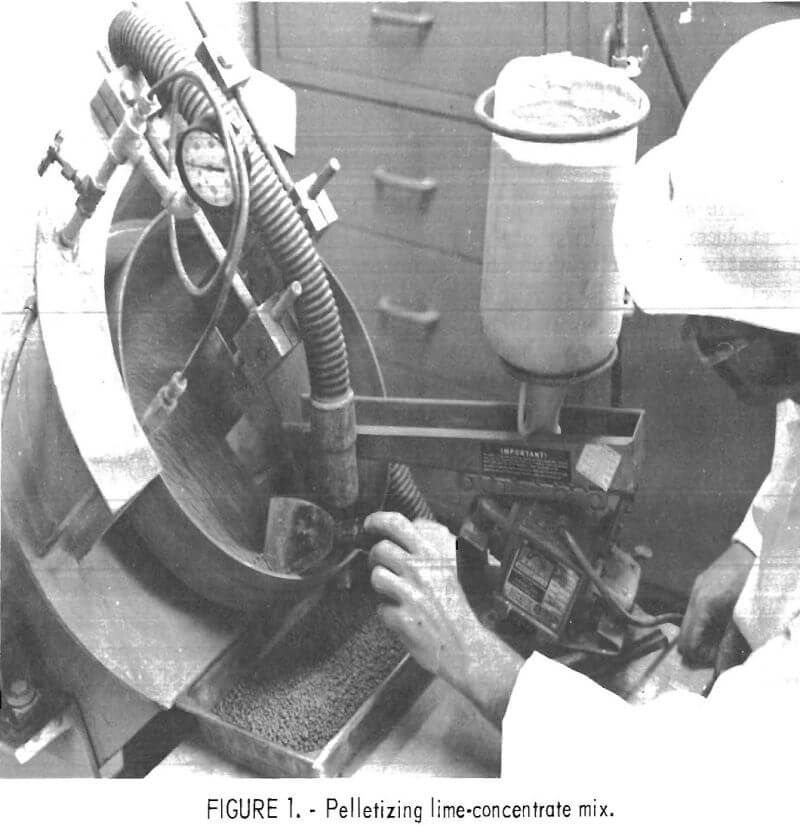
cylinder mounted in a split-tube furnace (fig, 2). A 10-percent load factor (400 g pellets/charge) was used in all tests as commercial kilns are usually operated with between 3 and 12 percent of their volume occupied by feed material. A peripheral speed of 40 ft/min (50 rpm) also was used as this gave a good tumbling action and was within the range (3-125 ft/min) encountered in large-scale operations. Offgases from the roasts were passed through a SO2 absorption system to determine sulfur retention.
In initial tests, all charges were roasted using an air flow sufficient to provide 2 times the theoretical amount of oxygen needed to complete reaction. After each test, the calcine was cooled to room temperature and leached with agitation (300 rpm) for 24 hours using 1 liter of 20-percent HCl (a 50-percent excess based on reaction). No heating was used during the leach. Pellets retained their shape very well in the roast and there was little dusting. In the leach, however, the pellets quickly disintegrated to a fine powder so no grinding was necessary.
Roasting Temperature
The effect of the temperature used in roasting chalcopyrite with lime was determined first. A range of 600° to 900° C was selected for testing after it was found that below 600° C, CaSO3 was formed, while above 900° C,
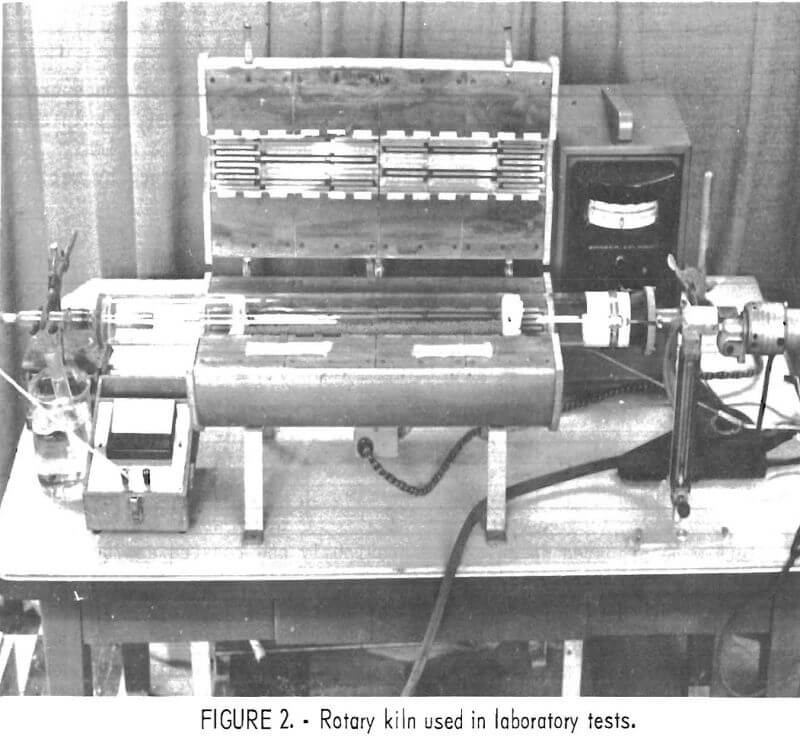
CaSO4 decomposed to CaO plus SO3. This is in agreement with the findings of other investigators. Conditions which were the same in all tests were particle size (concentrate, as received), air flow (4 liter/min), and retention time (4 hours). Results are given in table 1.
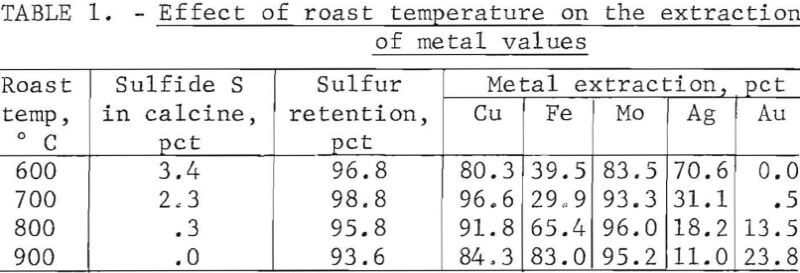
It is apparent that the results were highly temperature-dependent, reaching an optimum at about 700° C. Fuming, due to the decomposition of CaSO4, occurred above 700° C, becoming very noticeable at 900° C. None of the calcines contained any free lime. Calcines from roasts made at 700°, 800°, and 900° C contained no CaSO3; those made at 600° C contained about 0.7 percent CaSO3 and gassing (SO2 evolution) occurred when acid was added. Leach residues from calcines roasted at 700°, 800°, and 900° C filtered rapidly and no gypsum (CaSO4·2H2O) precipitated from the filtrate on standing. The residue from calcine prepared at 600° C filtered poorly and some gypsum was present in the filtrate.
Particle Size
To determine the effect of particle size, samples or rougher concentrate were ground wet in a ball mill for various lengths of time, using a pulp containing 50 percent solids to simulate thickener underflow from a primary flotation circuit. Particle size distribution was then determined by wet screening; results are shown in table 2.
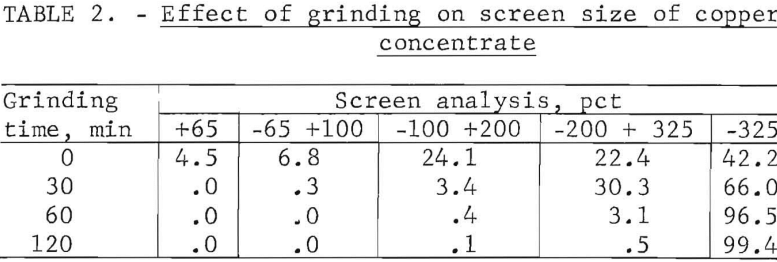
Pellets were prepared as described previously and roasted at 700° C for 4 hours, using an air flow of 4 liter/min. Test results are given in table 3. The results were somewhat erratic but did indicate that particle size had little, if any, effect on sulfur retention or metal extraction. Grinding the concentrate for 30 to 60 minutes yielded pellets with a much higher green strength, however. Tests in which the pellet size was varied from -2 +10 mesh to -28 +100 mesh gave similar results; that is, there was no significant effect.
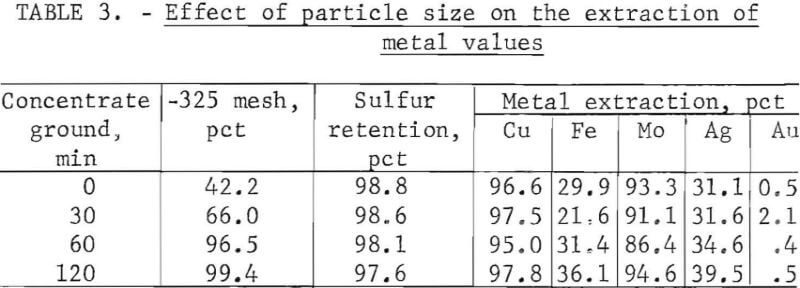
Air Flow
To determine the influence of air flow, pellets were prepared with concentrate, as received, and roasted at 700° C. In this case, both the air flow and retention time were variables as the total amount of air used in each roast was held at twice the theoretical requirement. Air to the kiln was metered at rates of 4, 8, 16, and 32 liter/min, corresponding to exit gas velocities of 30, 60, 120, and 240 ft/min. This covers the normal range encountered in large-scale operations where the superficial gas velocity usually exceeds 100 ft/min but is kept below 300 ft/min to minimize dusting. Data obtained are given in table 4.

To reduce capital expenditures, it is obvious that the shortest possible roast time would be desirable. However, at the highest flow rate used (32 liter/min), there was excessive dusting and extractions fell off because of cooling of the calcine during the roast. An intermediate flow rate (16 liter/min) was therefore selected for subsequent work.
Roasting Time
The effect of retention time during roasting was determined next using conditions found best in preceding tests. Runs were made for periods of ½, 1, 2, and 4 hours; equivalent to 1, 2, 4, and 8 times the theoretical air requirement. This is within the range (2 to 4 hours) normally encountered in commercial operations. Results are shown in table 5. It is apparent that at least a 1-hour roast (200 percent theoretical air requirement) is necessary. There was no advantage, however, in using a longer retention time.
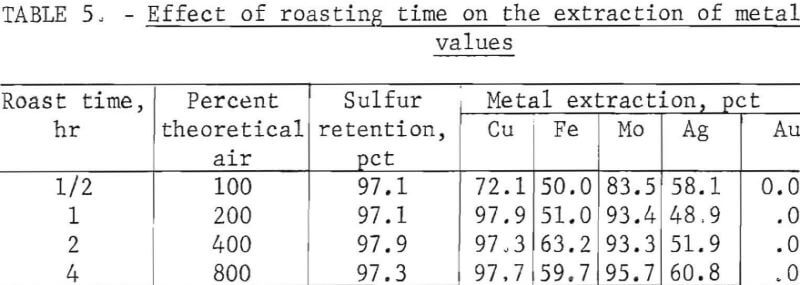
Leaching
In all previous tests, the calcine had been leached at room temperature for 24 hours to establish equilibrium conditions. This might not be practical in a large-scale operation where capital costs are determined in part by the time required for processing. Therefore, the effects of leach time and temperature were investigated, using calcine prepared under optimum conditions. Leaches were made at temperatures varying from ambient (30° C) to boiling (110° C). Results of these tests are shown in table 6. Temperature had a pronounced effect, the best results being obtained at the boiling point of the solution, When heating was used, a 15-minute leach appeared to be adequate for the recovery of Cu and Mo. An added advantage of heating was a large increase in the settling and filtration rates.
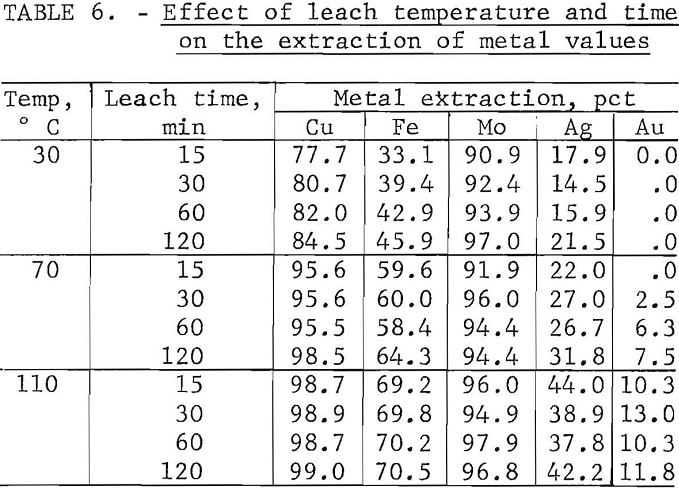
Small amounts of gypsum (CaSO4·2H2O) precipitated from the hot leaches on cooling. Although anhydrite is relatively insoluble in HCl, any soluble copper sulfates in the calcine react with CaO to form gypsum which dissolves in a hot leach, then crystallizes out on cooling since its solubility in HCl increases with temperature. It was necessary,therefore, to cool all slurries to room temperature before solid-liquid separation to avoid difficulties caused by CaSO4·2H2O precipitation.
The last variable to be investigated in the small-scale work was the effect of the amount of acid used in leaching the calcine. A 50-percent excess of HCl had been used in all preceding tests, but this was an arbitrary amount. The least possible amount of acid should be used, of course, as this determines both the size of leaching equipment and the cost of regenerating the acid.
Samples of 200 grams of calcine were leached at the boiling temperature using 255, 340, and 425 ml of 20 percent HCl, equivalent to 75, 100, and 125 percent of the amount needed to dissolve all of the copper and iron present. The results in table 7 show that the amount of acid could be varied over a wide range without affecting copper or molybdenum recoveries substantially. For example, in the first series of tests, only half as much acid was used as in the preceding work (the series of tests shown in table 6) and yet the copper recovery was almost identical. The chief effect of increasing the amount of acid appeared to be the dissolution of additional iron. Tests using 75 percent of the theoretical amount of acid resulted in a very thick slurry; best overall results were obtained with 100 percent of the theoretical amount of HCl. This amount gave a solid/liquid ratio of 35 percent which is within the range (30 to 60 percent solids) considered optimum for leaching conditions.
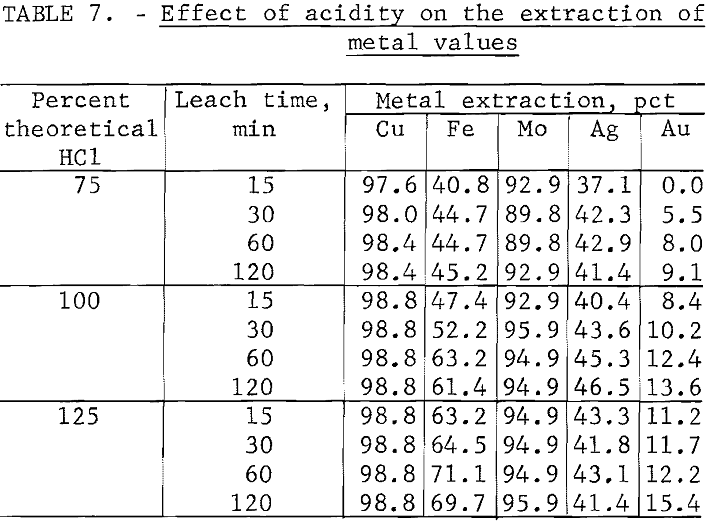
Large-Scale Rotary Kiln Tests
After completing the bench-scale tests, a series of large-scale runs was made to obtain operating data. The sequence of unit operations involved is shown in figure 3. A material balance based on the treatment of 100 pounds of rougher concentrate is also shown in table 8.
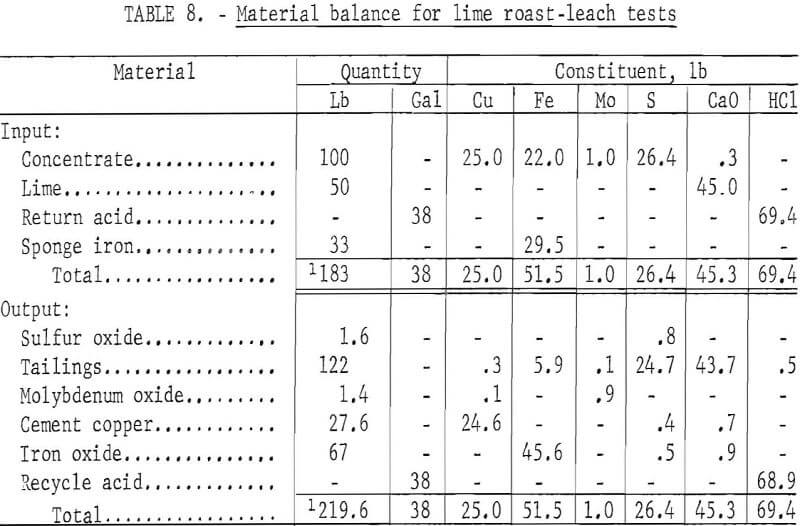
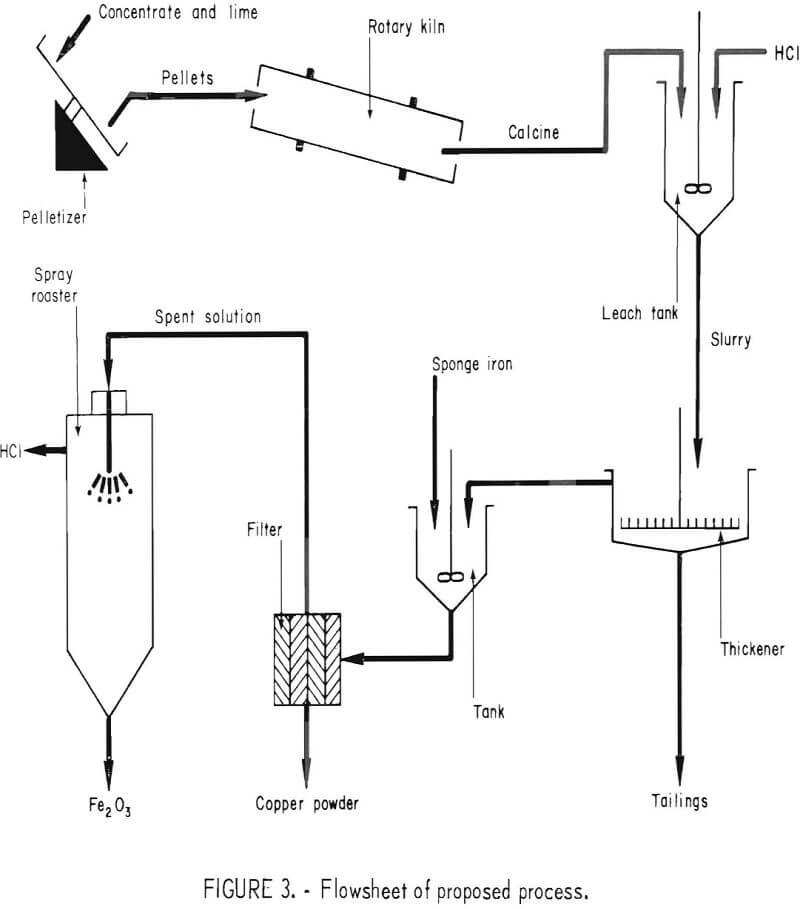
Lime Roast
The kiln used in the large-scale work (fig. 4) was a gas-fired, indirect- heated, rotary calciner equipped with a 6-½-inch ID by 11-foot-long stainless steel tube. Conditions found to be optimum in the laboratory were tried initially but had to be modified somewhat to accommodate the change from a batch to a continuous operation For example, pellets prepared from concentrate, as received, disintegrated in the large-scale kiln, and it was necessary to grind the concentrate to 90 percent -325 mesh to obtain adequate green pellet strength. Equipment limitations also held the peripheral speed of the kiln at a maximum of 14 ft/min, considerably below the 40 ft/min found best in laboratory tests. This necessitated the installation of lifters to obtain a good tumbling action. With lifters, the air velocity in the kiln had to be reduced to 40 ft/min to avoid excessive dusting. It was hoped that the temperature could also be reduced below that found optimum in bench-scale tests but this was not possible. Even a 50° drop, to 650° C, lowered the copper extraction to 95.7 percent and caused SO2 evolution during the leach. In all of the tests, the maximum possible feed rate (5 lbs/hr) was used. This was not quite sufficient to obtain an autogenous roast and 10 to 25 percent of the burner capacity was in use at any one time.
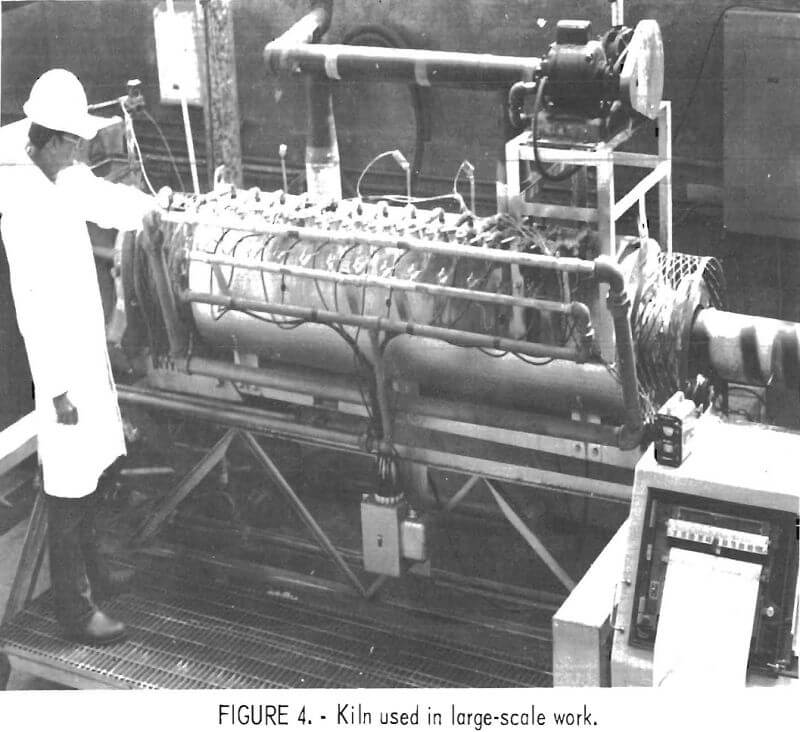
Roasting conditions found best for the large-scale work were as follows
a. Composition feed : 1 part concentrate, ground to 90 pct -325 mesh, mixed with ½ part agricultural lime (90 pct CaO).
b. Size feed : Lime-concentrate blend pelletized and screened to -3 +10 mesh.
c. Feed rate : 5 lb/hr (pellets dried 110° C),
d. Temperature : 700±10° C.
e. Air flow : 40 ft/min countercurrent (200 pct theoretical air requirement).
f. Retention time : 1 hr hot zone
g. Bed depth : 1 inch (10 pct load factor).
h. Peripheral speed : 14 ft/min (8 rpm)
i. Inclination : 0.15 in/ft.
One hundred pounds of concentrate gave 165 pounds of pellets which, when roasted, resulted in 190 pounds of calcine plus 5 pounds of dust which could be returned to the pelletizer. During the roast, the color of the pellets changed from gray to dark red and their bulk density increased from 55 to 71 lb/ft³. Offgases from the kiln were passed through a packed tower and scrubbed with a 10-percent NaOH solution to collect any sulfur oxides formed. Sulfur retention averaged 96.9 percent. None of the volatile constituents present in the concentrate, such as As, Se, Te, Sb, Mo, or Re, could be detected in the scrubbing solution; apparently they remained in the calcine as nonvolatile compounds.
Acid Leach
The calcine from 100 pounds of concentrate was leached with the theoretical amount of acid; that is, 38 gallons of 20 percent HCl. The acid was brought to 70° C before addition of the pellets, the heat of reaction raising the temperature to 95° C. No heating was used during the leach so that polyethylene equipment could be used. The slurry was agitated for 15 minutes with a titanium stirrer, then allowed to settle overnight to crystallize out any calcium sulfate that had dissolved in the leach. The bulk of the solids settled very rapidly, leaving only a small amount of fines in suspension. A trace of Separan MGL flocculated these immediately and gave an initial settling rate of 1.7 ft/hr. The clear, dark green solution, having a specific gravity of 1.26, was decanted, and the residue was filtered, washed, and dried at 110° C. The underflow, containing 66.9 percent solids, was difficult to wash free of chlorides because of the porous nature of the calcine. Washing by counter- current decantation would have been better but was not possible in this case as data for a material balance were being sought. The combined volume of leach solution and wash water was 37 gallons, somewhat less than the original amount because of evaporation during the leach.
About 36 percent by weight of the calcine dissolved in the leach. The HCl extracted 98.7 percent of the copper, 73.3 percent of the iron, 91.2 percent of the molybdenum, 3.4 percent of the sulfur as SO4=, 82.2 percent of the silver, but none of the gold. The leach solution also contained 3.6 g/l of calcium, equivalent to 3.9 percent of the CaO added to the concentrate. A number of elements, such as As, Re, Se, and Te, form calcium compounds that are either water or acid soluble; however, only As was detected in the leach solution.
The residue from the leach had a pink color and weighed 122 pounds, consisting mainly of CaSO4 (81.3 percent) in the form of anhydrite. It would normally be discarded unless, as in this case, it contained an appreciable amount of gold (0.3 ounce per ton). To recover precious metals, the residue, after washing, was treated at room temperature for 24 hours with 10 pounds of NaCN and 10 pounds of CaO per ton of solids, using a pulp dilution of 3:1. All but a trace of the gold dissolved.
Molybdenum Recovery
Molybdenum must be removed from the leach solution before copper can be recovered. Adsorption on activated carbon appeared to be a suitable method, giving better results than either ion exchange or solvent extraction even though the pH of the solution was well below the optimum (2.0). Based on the maximum Mo loading that could be obtained (8 to 10 percent), 15 pounds of coarse Pittsburgh char (CAL 12 x 40), equivalent to 3 lb/ft³, were added to the leach solution. The carbon slurry was then agitated gently for a period of 3 hours, a time which preliminary tests had indicated to be a minimum. Although there was only a slight change in the appearance of the solution during the 3-hour period, the Mo content dropped from 3.2 g/l to 0.1 g/l.
After adsorption, the carbon was separated by screening and thoroughly washed. Volume of the filtrate plus wash water was 37½ gallons. Molybdenum was removed from the carbon with aqueous ammonia, the resulting solution was brought to dryness, and the ammonium paramolybdate heated to 600° C to obtain the oxide. Some volatilization of NH4Cl was observed during ignition. The MoO3 product had a light green color, contained 66.4 percent Mo, and weighed 615 g equivalent to an overall Mo recovery of 90.5 percent. The only impurity present in a significant amount was copper (0.10 percent). No Fe, Pb, P, or S could be detected.
Copper Recovery
After Mo removal, powdered sponge iron (-100 mesh, 90 percent metallic iron) was added to the leach solution until gassing occurred. Enough agitation was used to keep the solids in suspension at all times. Scrap iron was not suitable for this step as the high copper content of the solution (79 g/l) caused “plating.” During the iron addition, the heat of reaction raised the temperature of the slurry to 70° C. Although the reduction of copper was almost instantaneous, agitation was continued overnight to allow as much of the excess iron as possible to dissolve. The slurry was then filtered and the cement copper washed and dried. Due to further evaporation during cementation, the volume of the filtrate plus wash water was reduced to 37 gallons. Treatment with sponge iron lowered the copper content of the leach solution to 0.1 g/l and changed its color from a dark green to a light amber. Iron consumption was 1.2 parts per part of copper.
The copper, which was coarse and crystalline with a bright metallic appearance, could be melted directly in a reducing atmosphere to obtain a recovery equal to 98.4 percent of the copper in the concentrate. Chemical analysis showed the metal to contain the following impurities in weight-percent: antimony, 0.013; arsenic, 0.360; bismuth, 0.041; iron, 0.022; lead, 0.091; nickel, 0.006; oxygen, 0.020; silver, 0.035; and sulfur, 0.004. Chlorine was present at <5 ppm. Arsenic, the chief impurity, could be removed by fire-refining together with most of the other contaminants. The bismuth content was high enough, however, to make electrorefining necessary if ASTM standards were to be met. Recovery of the silver would also be desirable.
Acid Regeneration
Following cementation, the solution was nearly saturated with ferrous chloride, containing 30 percent FeCl2 and 68 percent water. This is
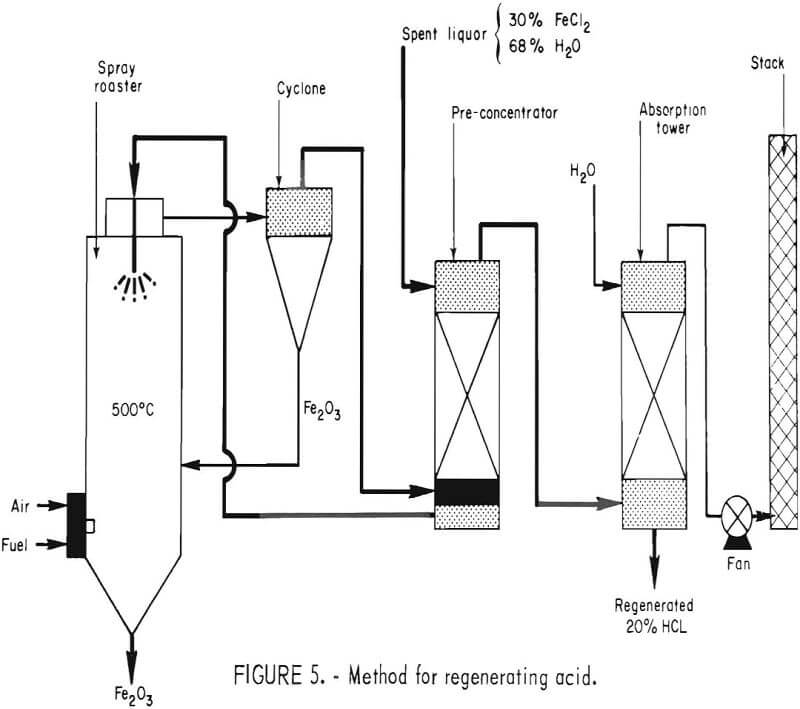
very similar in composition to the spent pickle liquor which is spray-roasted in steel mills to recover HCl. Many variations of the spray-roasting process are in commercial use; one example is shown in figure 5. The FeCl2 solution is pumped to a preconcentrator consisting of a simple packed tower. Here, the hot roaster gases are desuperheated by contact with feed liquor. This evaporates up to 25 percent of the water in the feed. The concentrated liquor is then pumped to the top of the roaster where it passes through spray nozzles into a brick-lined steel chamber heated to 500° to 600° C. Water and HCl are evaporated, and the FeCl2 reacts with O2 and H2O to form Fe2O3 and HCl. Most of the Fe2O3 falls into the cone bottom of the roaster where it is withdrawn through a rotary valve. The hot gases pass through a cyclone (where 95 percent of the remaining Fe2O3 is removed), through the preconcentrator, and then to a packed adiabatic absorption tower where the HCl is recovered.
Since the method is in common industrial use, no attempt was made to process the stripped solution during large-scale tests. In the laboratory, the ferrous chloride solution was sprayed into a flask heated to 500° C. This gave 20 percent HCl solution (the constant-boiling mixture) and black, granular hematite (Fe2O3) containing 67.8 percent iron plus the following impurities in weight-percent: calcium, 0.90; chlorine, 0.08; copper, 0.04; lead, 0.05; molybdenum, 0.04; and sulfur, 0.72–the calcium and sulfur being in the form of calcium sulfate. All impurities are removed from the circuit at this point, including any Mg that might be present in the lime used for roasting.
Fluidized Bed Tests
Some additional tests were made using a 4-inch Dorrco fluosolids reactor to determine if this type of equipment was suitable for the roasting operation. Satisfactory results were not obtained in small-scale tests, using a fluidized bed, but the large unit performed exceptionally well. Roasts were made at 500°, 600°, and 700° C using a retention time of 2 hours, a feed rate of 4 pounds per hour, a space rate of approximately 2 feet per second, and an air flow of 3.0 cubic feet per minute twice the theoretical requirement. Pellets were prepared as described earlier, using enough lime to combine with the sulfur in the concentrate. To fluidize properly, however, a smaller screen size (-10 +50 mesh) had to be used. The pellets broke up to some extent during the roast, slightly more than half of the charge being swept out of the bed. Overflow from the bed was combined with fines from the dust collection system for leach tests.
Calcines in this case were leached both with HCl (20 percent by weight) and H2SO4 (145 g/l). The HCl leach was made in exactly the same manner as in the small-scale rotary kiln tests; that is, samples of calcine were leached at room temperature for 24 hours using a 50-percent excess of HCl. In the H2SO4 leach tests, an equivalent amount of acid was used with other conditions being the same. A comparison of results obtained with the rotary kiln and the fluidized bed is given in table 9.
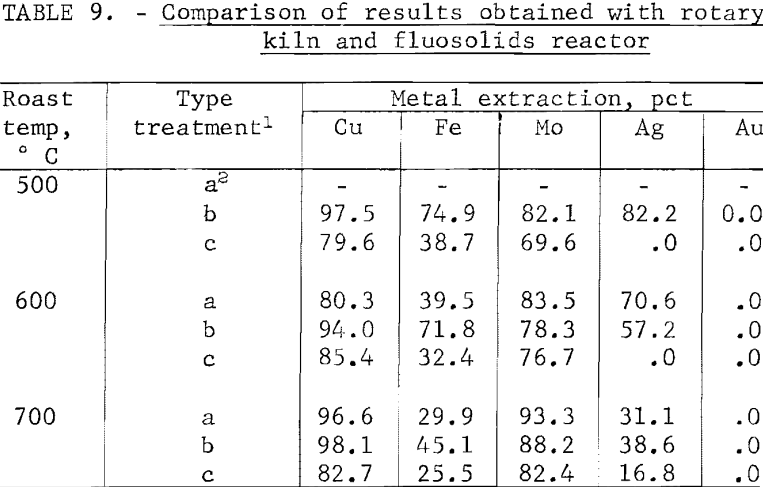
Sulfur retention (88.3 percent) was not quite as good as that obtained with the rotary kiln (96.9 percent). Extractions were excellent, however, when HCl was used but poor with H2SO4. Both copper and iron extractions exceeded those obtained with the rotary kiln, using HCl. The results were also less temperature-dependent. As in previous tests, the best overall results were obtained by roasting the lime-concentrate mix at 700° C. Considerable CaSO3 (3.6 percent) was present in the calcine roasted at 500° C and violent gassing (SO2 evolution) occurred when acid was added. The slurry from the leach was also very difficult to filter, containing a large amount of gypsum. In all cases, residues from the H2SO4 leaches were thixotropic and much bulkier than residues from the HCl leaches. The results indicate that a fluosolids reactor is, in most aspects, equal to or better than a rotary kiln for the roasting operation.
Conclusions
The method described appears to be suitable for small operations at locations where lime is readily available, stringent air and water pollution regulations must be met, and there is no ready market for sulfuric acid or elemental sulfur. Some of the advantages of the process are:
- The 10-percent sulfur oxide emission standard is easily met.
- A closed loop is used with no harmful liquid or gaseous effluents.
- Energy requirements are low.
- There is no buildup of impurities in the circuit.
- Copper is produced in a form which can be melted and fire refined to obtain a salable product.
- Precise control is not necessary; the method gives good results even with wide variations in operating conditions.
